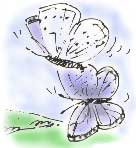 |
Holly BlueThursday, 2nd May 2002, West Yorkshire |
![]()
![]()
![]()
![]() Rocks |
History |
Workshop |
Links |
Home Page
Rocks |
History |
Workshop |
Links |
Home Page
![]()
 A blue butterfly flies from the path on Deadman's lane to sun itself on a wall. Its plain blue wings have a narrow black border scalloped around the edge with white. It has the odd piece missing from the edge of its wing but it doesn't look as if it's ever had any dark spots on the blue upper surfaces. The light-coloured lower wing surfaces are marked with a few greyish spots.
A blue butterfly flies from the path on Deadman's lane to sun itself on a wall. Its plain blue wings have a narrow black border scalloped around the edge with white. It has the odd piece missing from the edge of its wing but it doesn't look as if it's ever had any dark spots on the blue upper surfaces. The light-coloured lower wing surfaces are marked with a few greyish spots. Looking it up in the book it's what I suspected it was; a holly blue. The common blue is more strongly marked on the undersurface of the wings, with a number of orange spots. There's no orange on the holly blue.
Looking it up in the book it's what I suspected it was; a holly blue. The common blue is more strongly marked on the undersurface of the wings, with a number of orange spots. There's no orange on the holly blue. The individual we saw was a male; the female holly blue (right) has dark dark margins to the blue areas of the upper wings.
The individual we saw was a male; the female holly blue (right) has dark dark margins to the blue areas of the upper wings.Summertime Blues
Writing in Podiceps, the newsletter of Wakefield Naturalists' Society, in September 1991 Roger Gaynor noted;Holly Blues have mixed with the boys in blue near the police headquarters in the centre of Wakefield. They have also been seen around Crigglestone, Horbury, Sandal and Oulton. This appears to be part of a national expansion northwards, with large numbers also being recorded this year at Spurn Point and Danes Dyke near Flamborough Head. At one time this species was very limited in Yorkshire with the largest colonies being recorded in the Nidderdale area by Harrogate Naturalists' Society. A similar colour scheme has also been maintained by several broods of Common Blues at Bretton Old Brick Works, and very large colonies have been noted at Heath Common and the new Southern Washlands Nature Reserve.
![]()
Richard Bell,
wildlife illustrator
E-mail; 'richard@willowisland.co.uk'
![]() Next page |
Previous page |
This day in 2000 |
This month |
Nature Diary |
Home Page
Next page |
Previous page |
This day in 2000 |
This month |
Nature Diary |
Home Page
![]()